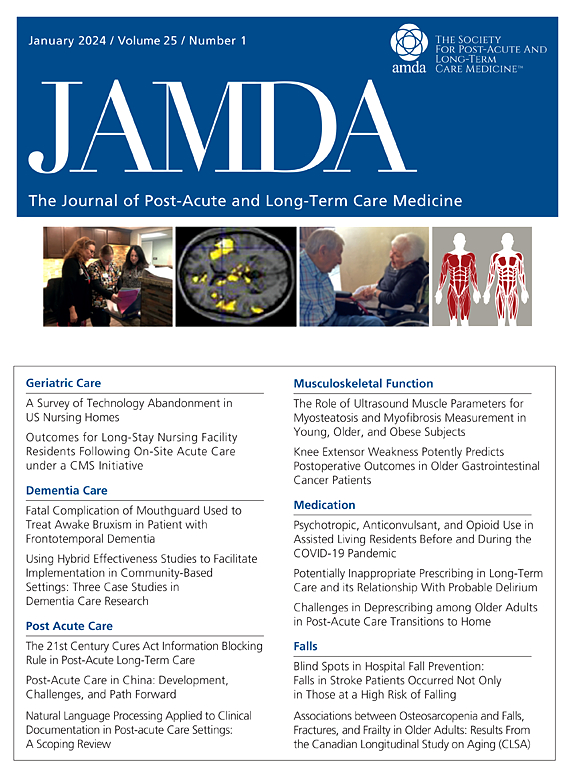一个多结局的预后模型社区居住的老年人入院的熟练护理机构急性后护理。
IF 4.2
2区 医学
Q2 GERIATRICS & GERONTOLOGY
Journal of the American Medical Directors Association
Pub Date : 2025-07-24
DOI:10.1016/j.jamda.2025.105775
引用次数: 0
摘要
目的:近20%的住院老年人出院到专业护理机构(SNF)进行短期康复。许多人随后经历了不良后果,如再次住院,过渡到长期护理而不是回家,或死亡。为了指导共同决策,我们为入住snf的老年人开发了一个多种结果的预后模型。设计:回顾性队列研究。环境和参与者:20%的全国医疗保险样本,年龄≥66岁的社区居住老年人在2017年至2019年住院后出院。方法:我们预测了两种结果:6个月全因死亡率和“成功社区出院”(出院后没有再住院或30天内死亡)。模型预测因子预先指定为年龄、性别、Elixhauser合并症评分、住院时间、选择性与紧急/紧急住院、医疗补助状况、主要医院出院诊断、手术程序和过去一年的住院情况。我们使用LASSO将38例Elixhauser合并症减少到12例,并使用逻辑回归来确定死亡率和成功出院结局的单独预测系数。通过判别(一致性统计量[c-statistic])和校正(校正图)来评估模型的性能。内部验证通过引导执行。结果:该队列包括523740例个体(中位年龄81岁,62%为女性,8%为黑人)。总体而言,22%的患者在6个月后死亡,54%的患者成功出院。调整后的优势比因结果而异(例如,住院时间比死亡率更能预测社区出院)。最终模型的乐观校正c统计量为6个月死亡率为0.753 (95% CI, 0.752-0.755),成功社区出院为0.692 (95% CI, 0.691-0.694)。校正图显示,该模型对两种结果都进行了很好的校正。结论和意义:在全国老年人样本中,这种多结果SNF预后模型具有良好的辨别和校准能力。风险预测可以帮助指导SNF临床医生、患者和护理人员之间的共同决策和未来规划。本文章由计算机程序翻译,如有差异,请以英文原文为准。
A Multi-Outcome Prognostic Model for Community-Dwelling Older Adults Admitted to Skilled Nursing Facilities for Post-Acute Care
Objectives
Nearly 20% of hospitalized older adults are discharged to a skilled nursing facility (SNF) for short-term rehabilitation. Many subsequently experience adverse outcomes, such as hospital readmissions, transitioning to long-term care rather than returning home, or death. To guide shared decision making, we developed a prognostic model for multiple outcomes for older adults admitted to SNFs.
Design
Retrospective cohort study.
Setting and Participants
Twenty percent national Medicare sample of community-dwelling older adults aged ≥66 discharged to an SNF after a hospitalization between 2017 and 2019.
Methods
We predicted 2 outcomes: 6-month all-cause mortality and “successful community discharge” (discharge to the community without subsequent rehospitalization or death within 30 days). Model predictors were pre-specified as age, sex, Elixhauser comorbidity score, hospital length of stay, elective vs urgent/emergency hospitalization, Medicaid status, principal hospital discharge diagnosis, surgical procedures, and hospitalizations in the past year. We used LASSO to reduce the 38 Elixhauser comorbidities to 12 comorbidities and logistic regression to determine separate predictor coefficients for the mortality and successful discharge outcomes. Model performance was assessed by discrimination [concordance statistic (c-statistic)] and calibration (calibration plots). Internal validation was performed via bootstrapping.
Results
The cohort included 523,740 individuals (median age 81, 62% female, 8% Black). Overall, 22% died by 6 months and 54% experienced a successful community discharge. Adjusted odds ratios varied based on outcome (eg, hospital length of stay was a stronger predictor of community discharge than mortality). The optimism-corrected c-statistics for the final model were 0.753 (95% CI, 0.752–0.755) for 6-month mortality and 0.692 (95% CI, 0.691–0.694) for successful community discharge. Calibration plots showed that the model was well calibrated for both outcomes.
Conclusions and Implications
In a national sample of older adults, this multi-outcome SNF prognostic model showed good discrimination and calibration. Risk predictions can help guide shared decision making and future planning among SNF clinicians, patients, and caregivers.
求助全文
通过发布文献求助,成功后即可免费获取论文全文。
去求助
来源期刊
CiteScore
11.10
自引率
6.60%
发文量
472
审稿时长
44 days
期刊介绍:
JAMDA, the official journal of AMDA - The Society for Post-Acute and Long-Term Care Medicine, is a leading peer-reviewed publication that offers practical information and research geared towards healthcare professionals in the post-acute and long-term care fields. It is also a valuable resource for policy-makers, organizational leaders, educators, and advocates.
The journal provides essential information for various healthcare professionals such as medical directors, attending physicians, nurses, consultant pharmacists, geriatric psychiatrists, nurse practitioners, physician assistants, physical and occupational therapists, social workers, and others involved in providing, overseeing, and promoting quality

 求助内容:
求助内容: 应助结果提醒方式:
应助结果提醒方式:


